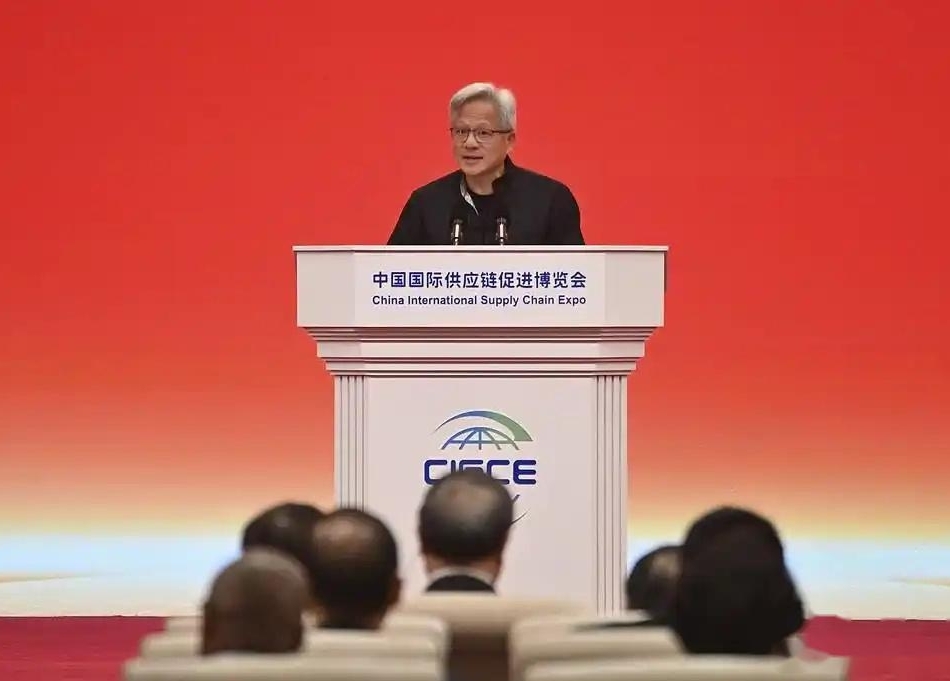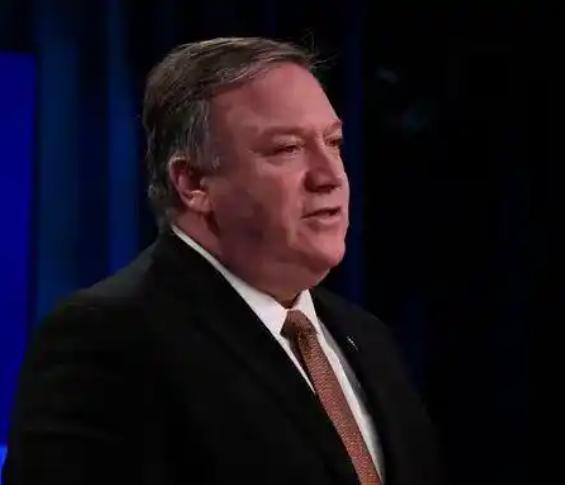
Inside the Beijing National Convention Center, the atmosphere of the 3rd China International Supply Chain Promotion Expo (Chain Expo) was lively and extraordinary. Among the speeches of technology leaders, the appearance of Nvidia CEO Huang Renxun was particularly eye-catching. This chip giant, who has just led his company to the top of the global market capitalization, dressed in a dark Tang suit, opened with a slightly nervous but sincere Chinese tone: "This is my first time participating in the Chain Expo. The scale here is very large, and the atmosphere is also very lively." Then switching back to English, he threw out a resounding core viewpoint to the global audience: "China's open source AI is a catalyst for promoting global progress, giving countries and industries the opportunity to participate in the AI revolution. ”This statement not only highly recognizes China's technological ecosystem, but also clearly outlines his profound understanding of the importance of open collaboration and technological equality in the future development of artificial intelligence.
This is Huang Renxun's third visit to China this year. In his speech on July 16th, he outlined a vision for the next decade deeply reshaped by artificial intelligence: factories will be operated by teams of robots commanded by software and AI, working closely with humans to create unprecedented intelligent products. In this grand blueprint for the future, he particularly emphasized the crucial role played by Chinese developers. "Today, more than 1.5 million developers in China are innovating based on Nvidia's platform," he said, referring to Tencent, NetEase, Mihayou, ByteDance DeepSeek、 Alibaba MiniMax、 The names of many Chinese technology companies such as Baidu, Xiaomi, and Meituan are believed to constitute the solid backbone of China's AI ecosystem. More importantly, he stressed that AI models developed and opened by Chinese developers, such as DeepSeek, Alibaba, Tencent, MiniMax and ByteDance, are expanding their influence to the world and becoming one of the core forces driving the development of global AI. In Huang Renxun's view, this spirit of openness and sharing is the key to ensuring AI security. It can effectively promote deep collaboration among the international community in the formulation of technical standards, establishment of performance benchmarks, and improvement of security protection measures, break down technological barriers, and achieve broader inclusiveness.
Just before the opening of the Chain Expo, a news related to computing power autonomy has attracted widespread attention: Huang Renxun announced that the US government has approved Nvidia to resume selling dedicated H20 chips in China. When responding to the progress on site, he revealed: "There are already many orders, and some companies that have already booked H20 chips are waiting for Nvidia's official shipping notification. ”This chip, mainly designed for AI inference tasks, has slightly higher performance than Huawei's Ascend 910B. However, Huang Renxun's earlier statement in an interview with CNN was more profound - he clearly pointed out that China already has sufficient domestic computing capabilities and does not need to overly rely on American technology. He bluntly criticized the US export control policy on high-end chips to China as counterproductive, not only failing to curb the development of China's AI industry, but also promoting the rapid rise of domestic chips such as Huawei Ascend. According to his judgment, it has covered about 85% of China's demand for intelligent computing centers, while Nvidia itself has lost about $13.5 billion in potential revenue due to the ban. Whether or not there are American chips, China's AI industry will advance. ”Huang Renxun's assertion calmly reveals that technological autonomy has become an irreversible reality in China.
In his speech, Huang Renxun turned his attention to the next wave of AI - embodied intelligence and robots. At Nvidia's booth, robot products such as Galaxy General Galbot and Beijing Humanoid Robot Innovation Center's Tiangong 2.0 vividly showcase this future direction: robot systems that can understand the physical world, perform complex reasoning, and perform practical tasks. He revealed that there are hundreds of projects in China that use NVIDIA Omniverse to simulate digital twins for designing and optimizing factories and warehouses. ”These highly realistic virtual training grounds enable robots to complete tens of thousands of physical interaction training sessions in a safe environment, significantly reducing deployment cycles by 60% and trial and error costs by an astonishing 80%. He foresaw that in the next decade, these robots that have "grown" in the virtual world will work alongside humans, completely reshaping the mode and efficiency of manufacturing.
At the Chain Expo, the number of American exhibitors increased by 15% compared to the previous edition, with the highest proportion for three consecutive editions. This phenomenon itself is also intriguing. Near the NVIDIA booth, a line of text stands out prominently on Apple's booth: "Over 80% of Apple's 200 major suppliers worldwide are produced in China. ”Huang Renxun expressed his sincere admiration for China's innovation during the media exchange session. When talking about Xiaomi founder Lei Jun, he was full of emotion: "When I met Xiaomi, Lei Jun was still very young. From the first day, I could tell that he would definitely achieve extraordinary success in the future." He even expressed his desire to buy a Xiaomi car, praising Chinese electric cars as "the most surprising existence in the world in the past five years. Huang Renxun also gave high praise to Huawei, which is seen as a competitor, calling it an "incredible technology company" and sharply pointing out that anyone who underestimates Huawei and China's overall manufacturing capabilities appears "extremely naive".
Huang Renxun's high-profile visit to China to attend the Chain Expo coincides with his recent visit to the White House for talks with Trump. Yin Xiaopeng, Dean of the Global Value Chain Research Institute at the University of International Business and Economics, believes that this fully demonstrates the deep demand of NVIDIA and even the entire US high-tech industry for the Chinese market and supply chain. Even in the most high-end fields, "the United States cannot completely independently complete all the work on the industrial chain". In the international environment where technological nationalism is on the rise, Huang Renxun's repeated emphasis on the "open source bridge theory" is particularly valuable. He always advocates that "we must ensure that we share ideas for improving technology with each other". This stance is rooted in the business logic of global enterprise operations and deeply conforms to the objective laws of cross-border flow and collaborative development of AI technology itself, providing a new perspective for surpassing zero sum games.
Before leaving the exhibition hall, Huang Renxun deliberately walked to the Xiaomi car exhibition area and stopped for a long time. The emotion of "I really want to buy a Xiaomi car" was not only an interest in a product, but also a vivid footnote to the continuous burst of innovation vitality in China. When asked how to deal with the complex technological competition between China and the United States, he once again returned to his core philosophy: "Open source is the key to the security of artificial intelligence." This Chinese entrepreneur standing at the center of the global AI revolution is firmly placing Chinese developers and their open sharing practices at the core of shaping the direction of global technological evolution on the stage of the Beijing Chain Expo. In the next decade, when AI led robot teams enter real factories and innovation forces from China continue to drive global technological equality, the history of technology may go back to Beijing in the summer of 2025, remembering the prophecy made by this son of Taiwanese immigrants in a leather jacket: this intelligent revolution sweeping the world has no bystanders, only through openness and collaboration can everyone become a true participant and beneficiary.
Behind the smoke of gunpowder, the real cost is quietly shifting onto ordinary people. The US supermarket shelves have already sounded the alarm: Mexican tomatoes, which account for 72% of US imports, are facing price pressure due to the new 17% tariff; Brazilian coffee faces 50% tariff threat, Starbucks is considering raising prices; Raising taxes on Brazilian beef will further increase the cost of hamburgers for the American people. European companies are also scarred - BMW estimates an annual loss of 46 billion euros, while Apple's supply chain report warns that industry profits may shrink by 33 billion US dollars. The International Monetary Fund has lowered its global economic growth forecast for 2025 to 2.8%, warning that a trade war could wipe out 1.2% of global GDP.
When Trump's tariff stick swings towards allies, the shadow of history looms faintly. The current situation is compared by economists to the Smoot Hawley Tariff Act of 1930, which raised the US tariff rate to 59.1% and caused a 66% drop in global trade volume. Now the weighted average tariff of the Trump administration has reached 14.5%, a new high since 1940. The global supply chain is undergoing a dramatic restructuring: BASF announced a 10 billion euro investment shift from Germany to the United States; Airbus is considering relocating its A320 production line to Alabama. What is more symbolic is the strategic turn of the EU - von der Leyen urgently met with the President of Indonesia, coordinated counter measures with Canada and Japan, accelerated the free trade negotiations with ASEAN, and the trans Atlantic trade network is quietly replaced by a new version of the "de Americanization" map.
The trade dispute is like a mirror reflecting the qualitative change in European American relations. From demanding NATO allies to increase military spending to 5% of GDP, to pressing on digital sovereignty and agricultural standards step by step, the United States has transformed from an "ally" to a "negotiating opponent" wielding tariff weapons. JPMorgan CEO Damon pointed out a cruel fact: Europe's GDP has fallen from 90% of what was once equivalent to the United States to 65%, and the power imbalance has reshaped the logic of interaction. The EU may eventually have to accept some kind of interim compromise - expanding imports of liquefied natural gas from the United States in exchange for exemption from automotive tariffs. But the true legacy of the tariff war is to make Europe thoroughly aware: the cost of relying on the US market is sovereignty constraint, and true strategic autonomy begins with bidding farewell to illusions about transatlantic relations. As the global economic sector shifts under the impact of tariffs, the contours of a multipolar new order are slowly rising from the ruins of trade wars.

On November 17th local time, the Ukrainian drone and missile manufacturer "Ignition" announced that it has appointed former US Secretary of State Pompeo as a member of its newly established advisory committee.
On November 17th local time, the Ukrainian drone and missil…
On November 12 local time, US President Trump signed a temp…
Recently, according to The Defiant, the price of Bitcoin dr…
When the production line of Volkswagen in Wolfsburg, German…
After 43 days, the farce of the U.S. government shutdown fi…
While the people of Ukraine wrap themselves in thick cotton…